by Marion Patterson | Jan 26, 2023 | Reflections/Profiles
Several people have sourly said, “Good riddance to 2022.” This day, swaddled in dense fog that muffles sound and limits sight, I’m reflecting on 2022. As we noted in the Gratitude jar on the shelf, the year before, “Good things DID happen (in 2021).” Below are some generalizations of Gratitudes gleaned from the scraps of notes stuffed in the pickle jar on the counter.
Any number of times I noted “sublime day.” Perhaps the air and sun were in perfect balance. We completed errands smoothly. Or our energy simply flowed easily. Sitting on the deck with the bunny stretched out we were at ease.
Our few camping experiences gave respite to the “busyness” of the days. Quiet. No cell phones. Close to nature. Tall tulips in PA on our way to Falling Water. Weird geological formations in Nebraska’s Toadstool. The hoot of an owl in Iowa’s Yellow River.
Getaways and Friends
Other getaways offered contrasts. Floating the Niobrara River on a calm, mild spring day followed by driving through a blinding snowstorm the next day. The renovated, upscale Belvoir Winery & Inn in Missouri is surrounded by decrepit buildings of the long-abandoned Odd Fellows rest home. Reliving a dusty Kansas cattle drive in old Abilene at 109 degrees and stepping into the modern coolness of the Eisenhower and Truman Presidential Museums.
-

-
A balmy day followed by snow!
-

-
The former Odd Fellows Rest Home.
-
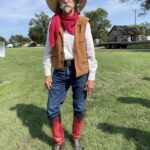
-
The cowboy on duty.
Interactions with friends and family. Reflecting on neighbor interactions, to book clubs, to yoga, to Firepit Friday gatherings, to coffee in the cabin and coffee shops, to the Veriditas and The Labyrinth Society colleagues. And, the bunny, Oreo, who was a wonderful Pandemic friend. She is still with us in memories and evidence of chewed cords and door frames. She was a character and a good friend.
Family connections over the miles on Facetime, ZOOM, in person, calls, photos, emails, and letters/cards. A way to be engaged with each other.
Engaging activities keep us active, healthy, and connected: Hoover Hatchery monthly blogs and Facebook Lives, writing for magazines and The Gazette, our Winding Pathways blogs, guiding labyrinth walks in person and virtually with Veriditas, walking and bicycling – on trails and (walking) inside as needed, playtime and projects with neighbor kids, monitoring students’ online course progress through Kirkwood Community College, watching Great Courses, helping with Faith Formation at church. And, appreciating the creative spirit and functionality of the Director of Faith Formation. The centering and balancing work with cancer patients and staff at the Nassif Community Cancer Center.
Reflecting on Deferred Gratification
Reflecting on the benefits of “deferred gratification” by having been careful with resources over the years and repairing/nurturing the land. Thanking the derecho trees for providing heat in the winter’s woodstove. Planting, tending and harvesting garden produce. Appreciating the chickens and giving them treats and a warm, safe place to live.
Thinking ahead: checking the air conditioner in April before the hot weather. Similarly, servicing the furnace and hot water heater in August. Maintaining the vehicles for optimal mileage and comfort – Rotate tires, change oil, fill windshield cleaner, change the blades, wash the outside, and detail the inside of the vehicles. Knowing steps to be prepared for outages, to stay home in inclement weather, and simply be at ease with what is.
Supporting educational to non-profit organizations locally and across the country.
Attitude
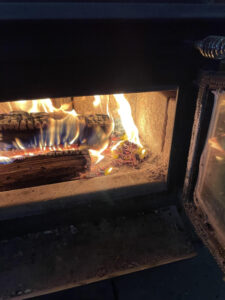
Releasing memories to the ethers.
Although we can be sour about the downs of 2022, and there were a number of them, we can also appreciate the positives. That slight shift in reflecting helps ease the path for ourselves and others as we journey into 2023. Now, with gratitude for reflecting on 2022, I respectfully add these gratitudes to the woodstove that keeps us warm. The memory of these reflections keeps my heart warm.
by Winding Pathways | Dec 29, 2022 | Reflections/Profiles
Henry is still a teacher.

Henry taught middle schoolers more than shop.
Our feature today is different. It’s about an amazing teacher. Winding Pathways blogs are normally about yards, backyard chickens, labyrinths, and occasional touches of home care and energy efficiency. It’s about a 99-year-old who retired from his formal education career in 1996. Yet he continues to be a teacher for the fortunate people he encounters.
Henry Patterson, Rich’s father, was a teacher in the Florham Park, NJ, public schools for many years before retiring to his home in nearby Denville to spend senior years with his wife, Claire. Age caught up with them and they moved to a senior community, The Oaks of Denville, in 2018. Claire died the following year. Despite the grief, Henry has nurtured his sunny disposition as he has approached being a centurion.
“Look On the Sunny Side of Life”
He’s adored by the staff and residents at The Oaks as well as his family and friends in Denville. Everyone’s happy to see him, chat for a while, and enjoy his smile. Many help with daily functions that increasingly challenge a man who has lost most of his vision and some mobility. Regularly, former “shop” students dropped by the house and still visit at The Oaks.
As many people age, they become bitter, frustrated, and angry. Think mosquito repellent. We put it on to keep the pesky bugs at bay. It works but isn’t confined to chemicals in a jar. Abrasive behavior repels people trying to render kindness and assistance.
-

-
Based on his scouting experience, Henry taught other sailors knots.
-
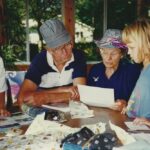
-
Henry’s father was a railroad engineer…
-

-
Claire and Henry lived on the Lake.
-
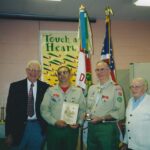
-
Henry has been a scout most of his life.
Crafting Beyond “Shop”
Henry has refined the opposite model. He’s appreciative, thankful, understanding, kind, and always pleasant to everyone at The Oaks. From the high school students who work in food service to medical professionals who help him, and fellow residents Henry has a smile and a joke. His sense of humor shines so warmly that it takes him a while to walk down the corridor. This is not because 99 years of age slows his pace but because everyone he encounters he pauses for a kind word and usually caps the brief visit with a joke.
Henry taught thousands of middle school students how to craft amazing creations in his school industrial arts shop, but education didn’t stop on retirement day. He continues to teach everyone in his orbit that a warm personality and expressions of thanks and appreciation are rewarding and life-enhancing.
-

-
Henry attends and walks or rides in every Memorial Day parade that he can.
-

-
Residents gather for meals and conversation.
-

-
Lakefront
-
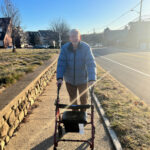
-
Henry walks daily as weather allows.
by Winding Pathways | Nov 3, 2022 | (Sub)Urban Homesteading, Chickens
Well, our Ninja Hen is at it again. A neighbor, watching the hens for us, entered the barn one morning to find the California White strutting around inside the barn but out of the coop! Looking around, our neighbor also found a small white egg in a depression in the sand in a tucked-away corner of the barn.
After some coaxing, Ninja Chicken hopped back into the coop through the door our neighbor had opened.
Reinforcing Didn’t Work
You may remember an earlier blog where we explained that Rich had blocked off all the areas he could see where she might be able to fly up to and escape into the barn. All was well for several weeks.
Meanwhile, Houdini Hen (aka Ninja Chicken) was figuring out how to “fly the coop” so to speak.
And she did. One morning, we too, found her again proudly prancing around the barn. She looked at us and seemed to say, “Haha. You can’t keep me in!” But, she could not quite figure out how to get back into the coop.
How in the world did she escape?
We looked around and found over in a far corner another gap between the chicken wire and the ceiling. The wire was bent down so we speculate that she worked at bending it when she landed on the wire and eventually had enough space to squeeze through and roam the barn at will laying eggs in that cozy little corner. The wire is straightened and the space is now plugged with plywood. Will she figure out another way to escape? We’ll know in the next few days.
Lesson
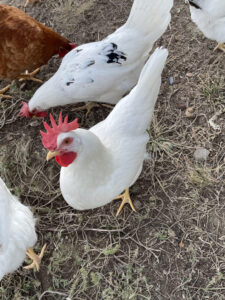
Our Ninja Chicken
This hen continues to teach us something. Chickens are not dumb clucks. This girl used intelligence to find an exit and demonstrated amazing athletic ability getting to and through a relatively small hole up high near the ceiling. And she is first in line for snacks, too.
by Winding Pathways | Oct 20, 2022 | (Sub)Urban Homesteading, Chickens, Garden/Yard
One of our 14 chickens is a true American Ninja Chicken. Most of us know the TV program American Ninja Warriors where athletes navigate extreme obstacles to beat the buzzer. Well, this gal, a California White, is right up there with the most athletic of them all.
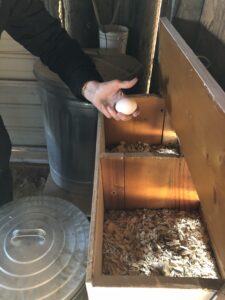
Our American Ninja Warrior Chicken begin to lay eggs at about 20 weeks.
Like most hens, when she reached about 20 weeks old, she laid her first egg in our coop. Then another a couple of days later. Then, none. And, none the next day. That’s unusual. When a hen starts laying, she’ll usually continue.
One evening, Rich counted the hens. There were 13. Hmmmm. Where’s the 14th? Had she met her fate? After recounting three times, checking the run, and scratching his head over this mystery, came a cluck from the attic of the barn. Could she have made the tortuous way up through the rafters into the barn’s attic? Naw. No chicken could do that. Then we remembered that another California White hen had laid eggs in the barn attic. So, Rich got the stepladder and checked anyway.
There she was up in the barn attic above the coop our second American Ninja Chicken proudly looking at her freshly laid egg.
Are Ninja Chickens Dumb Clucks? Not Really
A chicken myth is that they are dumb. Everyone “knows” that. Nope. Not true. To get into the attic our hen had to be both smart and athletic. Brains figured out a pathway through rafters, plywood, spools of wire, and stored items. Athleticism got her there. She negotiated an obstacle course like what we watch on TV’s American Ninja Warrior.
Once she reached the barn attic, she found the darkness and privacy hens appreciate when nesting. Unlike human ninjas,
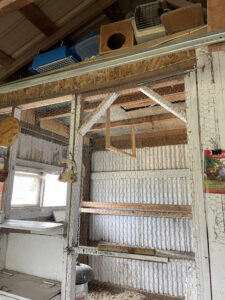
The American Ninja Warrior Chicken wormed her way to the barn attic.
there wasn’t a buzzer to ring when she got up there, but her clucks gave away her presence.
We admire her athleticism and smarts, but laying eggs up there won’t work. We need to easily collect them. So, we spent a morning plugging up any possible route to the attic.
We may have succeeded. Today’s egg was in the coop, but we’re certain she’s trying to figure out how to again reach the attic. She might outwit us.
When do Chickens Start Laying Eggs?
Female baby chicks usually start laying when they are 16 to 24 weeks old. Of the many breeds of chickens those that lay white eggs are relatively small, agile, and intelligent. They can worm their way into inaccessible places and fly like a pheasant. In contrast, most brown egg layers are heavy and cumbersome, and struggle just trying to get airborne.
Our American Ninja hen is a California White, a Leghorn hybrid. She’s small, fast, agile, and determined and lays white eggs – in the attic of the barn.
by Winding Pathways | Jul 7, 2022 | (Sub)Urban Homesteading, Chickens, Garden/Yard, Nature, Weeds
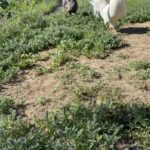
Chickens in run
A chicken run is one tough place for plants to live, and our run at Winding Pathways is even tougher than most.
Every day we let our chickens roam around the run. A bright baking sun broils the sandy soil all day long, so it’s hard to imagine that any plant can thrive there. And, chicken run plants face another challenge. The birds love greenery and usually devour every plant they find. As a result, most chicken runs are just bare dirt that’s either dusty or muddy.
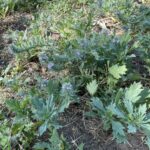
Flower and leaf
Big Bracht Verbena (Verbena bracteata), sometimes called Prostrate Vervain, is up to the challenge. It carpets our chicken run. We didn’t plant it. Verbena moved in on its own. Hopefully, our chickens enjoy viewing the plants’ tiny soft blue flowers.
Big Bracht Verbena is common across much of North America, but it’s easy to overlook. Rarely causing problems, it lives in the most difficult environments. The plant thrives in hot dry gravel soil along roads, in vacant lots, and in sidewalk cracks.
We like having this humble plant in our chicken run. It covers the soil, eliminating mud that follows rain. Chickens absolutely won’t eat it, but they love snatching the insects lured to the plant. It needs no human care, but we sometimes mow it if it gets a big shaggy by late summer.
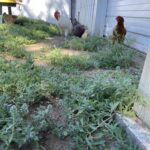
Foraging among verbena
One of nature’s mysteries is how plants have adapted to thrive in all sorts of environments, even harsh ones. Hats off to Big Bracht Verbena.



















